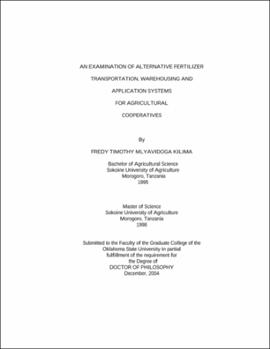| dc.contributor.advisor | Kenkel, Phil | |
| dc.contributor.author | Kilima, Fredy Timothy Mlyavidoga | |
| dc.date.accessioned | 2013-11-26T08:22:01Z | |
| dc.date.available | 2013-11-26T08:22:01Z | |
| dc.date.issued | 2004-12 | |
| dc.identifier.uri | https://hdl.handle.net/11244/6518 | |
| dc.description.abstract | Scope and Method of Study: The study investigated economic issues relating to fertilizer warehousing and application. The impact of a shift from anhydrous ammonia to dry and liquid (UAN) formulations on fertilizer warehousing, transportation and application costs were examined. Warehousing and transportation cost efficiencies were also investigated and the optimal level of warehouse centralization was determined. The impact of farm size and available application days on fertilizer application costs were also examined. The study examined four alternative fertilization systems with the nitrogen component involving fall anhydrous combined with a spring application of UAN, fall urea combined with spring UAN, fall urea only and spring UAN only. A capacitated discrete mixed integer-programming model was used to select the warehouse configuration and application fleet that minimized transportation, warehousing, machinery and application costs subject to supply, demand, and facility and equipment capacity constraints. Data for the model were obtained from an Oklahoma grain and farm supply cooperative and historic records. Machinery efficiency was assessed using daily losses in machinery hours attributable to warehouse to field travel time. | |
| dc.description.abstract | Findings and Conclusion: The results indicated that the case-study cooperative could reduce costs by partially centralizing its fertilizer warehouse and application activities. However, a single centralized warehouse was not cost-effective because increases in transportation, application, and machinery ownership costs offset financial gains from warehouse size economies. The results emphasize the importance of transportation and equipment ownership costs in the overall fertilizer supply chain. A shift from anhydrous ammonia to dry and liquid formulations was indicated to have a relative small impact on fertilizer agribusinesses with the major impact being borne by the producer in the form of increased material costs. Analysis of machinery use-efficiency indicates that applicators were 18% more efficient when used in large fields than in small fields. These results could justify differential pricing of application services. The number of available application days had a major impact on the machinery compliment and total system costs. A 25% reduction in available days was indicated to increase system costs by over 10%. | |
| dc.format | application/pdf | |
| dc.language | en_US | |
| dc.rights | Copyright is held by the author who has granted the Oklahoma State University Library the non-exclusive right to share this material in its institutional repository. Contact Digital Library Services at lib-dls@okstate.edu or 405-744-9161 for the permission policy on the use, reproduction or distribution of this material. | |
| dc.title | Examination of alternative fertilizer transportation, warehousing and application systems for agricultural cooperatives | |
| dc.contributor.committeeMember | Stoecker, Art | |
| dc.contributor.committeeMember | Epplin, Francis | |
| dc.contributor.committeeMember | Huhnke, Raymond | |
| osu.filename | Kilima_okstate_0664D_1096.pdf | |
| osu.accesstype | Open Access | |
| dc.type.genre | Dissertation | |
| dc.type.material | Text | |
| dc.subject.keywords | fertilizer | |
| dc.subject.keywords | transportation | |
| dc.subject.keywords | warehousing | |
| dc.subject.keywords | application systems | |
| dc.subject.keywords | agricultural cooperatives | |
| thesis.degree.discipline | Agricultural Economics | |
| thesis.degree.grantor | Oklahoma State University | |
